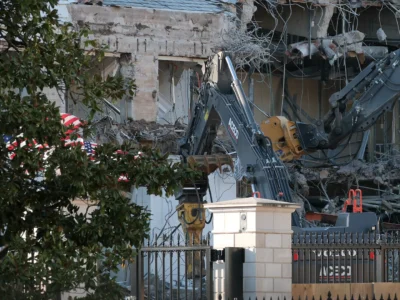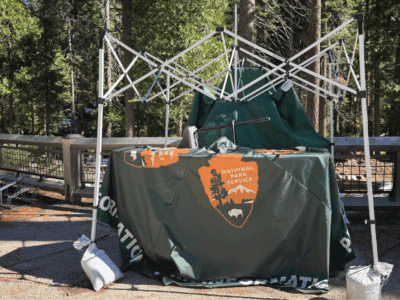A summer meditation on the meaning of wilderness
It’s outdoor weather in far northern California, my favorite place on the planet. A day hike yesterday in the beautiful Trinity Alps Wilderness reminded me of the central question of wilderness management: how much anthropogenic modification for what purposes is compatible with the wilderness experience? This hike provided two contrasting perspectives on that question.
It’s just gone spring in the high country here, after an unusually snowy winter. The azaleas, lady’s slippers, and darlingtonia are just coming into bloom, snow still lingers in patches and on the peaks, and the creeks are running high, fast, and cold.
We were headed up Swift Creek, which in this season fully justified its name. The trail split a little ways out, with one fork crossing this impressive bridge:
We didn’t take that path, not because we were averse to crossing the bridge but because the meadows we wanted to see lay in the other direction. Had we wanted to cross Swift Creek, though, we could easily have done so at the bridge. Even people much younger and fitter than us could not have crossed safely under the current spring flow conditions (the picture doesn’t do the water levels justice) if there were no bridge.
The other fork took us up through the wildflower meadows we were seeking. It required us to cross a couple of smaller tributary streams, which we did at narrow points with the help of some well-placed fallen trees. We turned around when we got to this stream, which we deemed impassable:
Note the footing from a former bridge, which was not replaced after it washed away in a flood.
Was the path we took “better” wilderness than the other one, because it lacked a convenient bridge crossing?
The Wilderness Act says yes. It defines wilderness in the following terms:
A wilderness, in contrast with those areas where man and his own works dominate the landscape, is hereby recognized as an area where the earth and its community of life are untrammeled by man, where man himself is a visitor who does not remain. An area of wilderness is further defined to mean in this Act an area of undeveloped Federal land retaining its primeval character and influence, without permanent improvements or human habitation, which is protected and managed so as to preserve its natural conditions and which (1) generally appears to have been affected primarily by the forces of nature, with the imprint of man’s work substantially unnoticeable; (2) has outstanding opportunities for solitude or a primitive and unconfined type of recreation; (3) has at least five thousand acres of land or is of sufficient size as to make practicable its preservation and use in an unimpaired condition; and (4) may also contain ecological, geological, or other features of scientific, educational, scenic, or historical value.
The Swift Creek bridge is a “permanent improvement” which makes “the imprint of man’s work” clearly noticeable. The bridge dates from years before the area was declared wilderness in 1984. It would not be built today, just as the one above it has not been rebuilt.
Still, I’m not sure it interferes in any important way with wilderness values. I’ve never been in a wilderness area where you couldn’t see anthropogenic effects. It’s common to see sawn log ends where downed trees have been cleared off the trail, for trails to be blazed, and for drainage to be mildly engineered using logs and rocks. Those steps reduce the impacts of hiking, and at the same time make it easier to hike through the area with less attention to your feet. Is that a bad thing? I don’t think so. The point of a wilderness visit for me is to experience, observe, and learn more about the natural surroundings. If the tread is easy, I can pay more attention to the surrounding birds and vegetation. Contemplative recreation seems more, rather than less, likely if there is a trail and it’s easy to follow.
Of course the bridge is a bit more jarring than a log removed from the trail, but I don’t know that it’s that different in kind. A bridge can allow access to areas that otherwise could not be observed, facilitating precisely the sort of contemplative recreation wilderness advocates have long admired and sought to encourage. Perhaps that means more people on the trail, which at some point is a problem in and of itself for a wilderness experience, but the Trinity Alps, which are remote from any population center, are a long way from being overrun.
I’ve encountered far more jarring conditions on many wilderness trips — startlingly low military jet overflights in the Indian Heaven Wilderness of southern Washington; the constant drone of the nearby interstate in parts of the Desolation Wilderness near Lake Tahoe; early morning strafing of our lakeside campsite by planes dropping baby trout in California’s Yolla Bolly-Middle Eel Wilderness; and gold miners (legally) using jeeps to access their claims in southern Oregon’s Kalmiopsis Wilderness. All of those things represent, for me, human dominance of, deliberate disruption of, and disregard for nature and its rhythms. A bridge over a large creek that would be difficult for most people to ford most of the time in most years strikes me as potentially quite different, at least if those who cross it do so to observe, enjoy, and admire the more or less intact nature that surrounds it.
That bridge seems more likely to serve as a symbolic as well as literal access point to a respectful relationship with nature than as a barrier to that kind of relationship. Perhaps it doesn’t belong in a designated wilderness — I don’t object to keeping some places sufficiently inaccessible that only those already committed to interacting with nature on an intimate level can or will access them. But surely there is an important place for trails providing greater accessibility to those who might build such a commitment.
Reader Comments
One Reply to “A summer meditation on the meaning of wilderness”
Comments are closed.








You need to make up your mind, footprint or no footprint, that is the question. You seem torn between whether a bridge crossing belongs in the Swift Creek drainage. It seems to me when things are convenient or to your liking you support the access. Where does it stop? Too bad you couldn’t cross Parker Creek (that’s the stream that stopped you from moving into Mumford Meadows, which, by the way, is beautiful). I’ve crossed this stream in early Spring, and no, its not easy. It means breaking off trail and accessing a safe spot to cross. Am I crossing a line by doing this? Leaving another big, fat, size 14 hiking boot that shouldn’t be where its at? FYI, there is no access point in the Trinities that has not been used heavily by humans since the nineteenth century, do your homework. The Trinities are laden with old mines and history of townships. The same trails you walk were once used by mule trains consisting of fifty to sixty pack animals (talk about impacting wilderness). These were the people that pioneered this wilderness and left to us to enjoy. Don’t over-analyze. If it were up to me, I’d tear down every bridge and burn every sign. People who need these crutches don’t belong in “The Wilderness”. I find it hard to tolerate these types of people in my back yard. They preach green energy, no footprint and keep nature as it is. However, I consistently come across camps left by these folks, broken wine bottles and tin foil in the fire ring (no, that stuff doesn’t burn). Yes, witnessed it personally, immediately of these folks coming out of camp, by the way, out of my regular camp, have never seen it so disgusting. And yes, the coals in the fire were still hot. Can’t even dig a cat hole to bury their own excrement. Not to mention, they were quite belligerent towards me, maybe because I’m carrying a rifle during deer season?
So you, from Berkley, so well educated, educate me as to what you’re willing to do to insure your kind will respect my backyard. What do your kind do to insure this stays a “Wilderness” as you put it? I have the solution, stay away. Not to stereotype, but I’ve seen your kind a million times over up here. Bottom line, judging from your campsites, you have no respect for the country. I eat, sleep and breath these mountains. I catch fish and hunt deer in these mountains. I have a greater respect for what God gave us than anything you could possibly fathom,
Once again, stay away, try and fix what’s already too far gone where you live. BTW, what have you done to insure our wilderness areas stay wilderness areas? As sad as it sounds, it takes cash….hunting and fishing licenses to start. When was the last time you bought one of those? That is what keeps wilderness areas, wilderness areas. You talk the talk, now walk the walk. I enjoy where I live, enjoy what I do….when you come to my country, respect it or stay out. You enjoy the sights, respect nature and remember…..your campsite is the biggest footprint……
Just for the record…”Wilderness” is personal perception. The Trinities are home, Los Angeles is the wilderness.